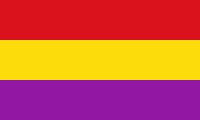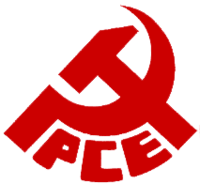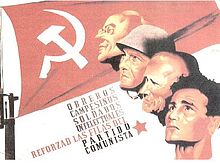- Communist Party of Spain
-
Communist Party of Spain
Partido Comunista de EspañaSecretary-General José Luis Centella Founded November 14, 1921 Merger of Spanish Communist Party
Spanish Communist Workers' PartyHeadquarters C/Olimpo, 35
28043 MadridNewspaper Mundo Obrero Youth wing Communist Youth Union of Spain Membership 35,000[1] Ideology Communism
MarxismNational affiliation United Left European affiliation Party of the European Left European Parliament Group European United Left-Nordic Green Left Trade union afilliation Workers' Commissions Website pce.es Party flag 
The Communist Party of Spain (Spanish: Partido Comunista de España, PCE) is the third largest national political party in Spain. It is the largest member organization of the United Left electoral coalition and has influence in the largest trade union in Spain, Workers' Commissions (CCOO).
The youth organisation of PCE is the Communist Youth Union of Spain. PCE publishes Mundo Obrero (Workers World) monthly.
Contents
History
Establishment and pre-republican era
The PCE was the result of a merger between two organisations: the original Spanish Communist Party (Partido Comunista Español or PCE) and the Spanish Communist Workers' Party (Partido Comunista Obrero Español or PCOE). The former was created in April 1920 from portions of the Socialists' youth organisation (Federación de Juventudes Socialistas or FJS) while the latter had been formed from a union of dissident Socialists (terceristas) and members of the General Union of Workers (Unión General de Trabajadores or UGT) who regarded the original PCE as not properly representative of the working class.[2]
The two parties joined in the new Partido Comunista de España on November 14, 1921. The unified PCE became a member of the Third International and held its first congress in Sevilla in March 1922. In May, Jules Humbert-Droz, the top Comintern official in Western Europe, arrived in Spain to supervise the still fractious party and would continue to do so until the establishment of the republic.[3]
By the end of 1922 the party had approximately 5,000 members.[4] The PCE's left-wing engaged in political violence, especially in Bilbao, largely directed against other leftists. A party leader's bodyguard shot and killed a Socialist in November 1922 and organized party militants attempted a general strike in August 1923 that ended in a shootout at the barricaded party headquarters, resulting in twenty communists dead or injured and another seventy arrested.[4]
With the advent of the dictatorship of Miguel Primo de Rivera in September 1923, political parties, including the PCE, were repressed and rendered largely powerless though not dissolved. The party continued to publish its weekly newspaper La Antorcha until 1927. In November 1925, PCE leaders joined with Comintern officials and leaders of the Catalonian-separatist Estat Català in endorsing a revolutionary program calling for:
-
- Abolition of the Primo de Rivera dictatorship and the monarchy,
- Creation of a república federativa popular (federal popular republic),
- Recognition of independence for Catalonia, the Basque Country, and Morocco,
- Total freedom of association,
- Expropriation of large estates and distribution of land to peasants,
- Organisation of workers' councils in industry,
- Formation of a central committee for revolution consisting of respresentatives from several parties as well as a military committee, and
- A planned insurrection in Madrid.[5]
However, Moscow urged a cautious approach and the CNT and Basque nationalists were reluctant to cooperate with communists, so the plans were never carried out.[6] The PCE continued to suffer from repression and dissension. The party's second secretary general, José Bullejos, purged the party of politically suspect members, and was himself arrested in 1928. In 1930 the arguments over doctrine led the Catalan-Balearic Communist Federation (FCCB) to break from the party and associate with the International Right Opposition. Amid this infighting, Comintern official Dmitry Manuilsky reportedly stated that, while Spain had "an excellent proletariat", it had only "a few little groups, but not a communist party."[7]
Thus, the PCE was in a very debilitated state when the Second Spanish Republic was proclaimed in 1931. On December 3, 1933 the first PCE parliamentarian, Cayetano Bolívar Escribano, was elected. Bolívar was jailed at the time of elections and left imprisonment to occupy his post in the parliament.
Popular Front and Civil War
Communist Party of Spain PCE federations
PSUC- UJCE
Mundo Obrero - CC.OO.
United Left
European LeftDolores Ibárruri
Enrique Líster
Santiago Carrillo
Julio Anguita
Francisco FrutosPolitics of Spain
Political parties in Spain
Elections in SpainCommunism
Eurocommunism
World Communist MovementPCE was a small party during the initial years of the Republic, until it began to grow due to the victory of the Popular Front (of which the Communists had been a constituent part) in February 1936 and the beginning of the Spanish Civil War in July of that year. The PCE, directed by José Díaz and Dolores Ibárruri (known popularly as La Pasionaria), worked consistently for the victory of the Republican forces and the Popular Front government, but was wary of the popular social revolution that was being waged by Spanish workers. The communists have also been seen as one of major factors behind the 1937 Barcelona May Days, when anarchists and Workers' Party of Marxist Unification (POUM) were violently suppressed, with many imprisoned.
The PCE thus helped the republican government to violently suppress the Spanish Revolution, as the Soviet Union did not want to antagonise France and Britain while facing the growing Nazi threat. Being a well-knit and highly disciplined organisation, the PCE could in spite of its numerical weakness play an important part in the war. In the first five months of the war, PCE grew from 30,000 members to 100,000. It also founded a Spanish branch of the International Red Aid, which assisted the Republican cause considerably.
In 1936, due to the special political situation in Catalonia, Partit Comunista de Catalunya (the Catalan branch of PCE) was separated from the party to fuse with other socialists to form Partit Socialista Unificat de Catalunya. Since then the PCE does not have an organization in Catalonia, but relies on a regional referent party. This set-up has been imitated by many of the communist splinter groups in Spain.
Resistance and reorientation
After the Republican defeat in April 1939, the PCE was persecuted by the dictatorship of General Francisco Franco (1939–1975), although maintained the best organization among the opposition parties inside Spain. During the initial years of the Franco regime, PCE organized guerrilla struggles in some parts of the country.
From the signing of Molotov-Ribbentrop Pact to the German assault on the Soviet Union on June 22, 1941, Spanish communists pursued neutralist policies with regards to Germany's aggression against Poland and France, regarding the war as imperialist and unjust. Much like the identical positions of other Moscow-directed Stalinist parties, this position was changed immediately after Germany invaded the Soviet Union.
A large part of the party membership was forced into exile. Some PCE members went to the Soviet Union and fought as volunteers for the Red Army during the Second World War, such as General Enrique Líster. A large section of PCE members were based in France, were a major party organisation was set up. During the later half of the Franco years, PCE changed its strategy and started organizing Workers' Commissions (CC.OO.) within the official trade union apparatus. CC.OO. and PCE gained strength and became the backbone of the opposition forces in the country.
Dolores Ibárruri, "La Pasionaria", a dedicated follower of consequent Comintern policies, replaced Jose Diaz as General Secretary in 1942, and held the position until 1960. Santiago Carrillo was General Secretary from 1960 to 1982. Carrillo put the party on a eurocommunist course, distancing it from its Leninist origins. Carrillo accepted concessions to the 'bourgeoisie', accepting the restoration of a liberal democracy and constitutional monarchy. This was regarded by many Party members as a treason, for these concessions were made to classes the Party's doctrine called 'exploiters'. The Party was legalized after the January 1977 Atocha Massacre, on April 9, 1977 as one of the last steps in the Spanish transition to democracy. Only weeks after the legalization, PCE had over 200,000 card-holding members.
Transition to democracy
But the concessions made by Carrillo (labelled 'revisionist' by his orthodox communist opponents) and the social democratisation of the party under his leadership provoked dissent amongst party ranks. Several party members left the party. Enrique Líster broke away in 1973 and formed the Partido Comunista Obrero Español. Other more radical left-wing groups that broke away were Partido Comunista de los Trabajadores (formed by the Left Opposition of PCE in 1977) and PCE (VIII-IX Congresos) (formed in 1971).
 PCE sticker
PCE sticker
In the first elections after the transition in 1977, PCE obtained 10% of the votes and received a similar result in 1979. In 1982, PCE suffered an electoral defeat. The electoral defeat and broad dissent amongst the party membership against Carrillo's social democratic path led to the removal of Carrillo from the party leadership. In 1985 Carrillo was expelled from the party.
In 1986, during anti-NATO protests, the PCE and other left wing groups formed Izquierda Unida (IU). At the moment, the PCE has about 30,000 members. From 1982 to 1988, the General Secretary was Gerardo Iglesias. Between 1988 and 1998, its General Secretary was Julio Anguita and since 1998 the post is held by Francisco Frutos, a member of the Cortes.
Notably PSUC, the Catalan referent of PCE, did not reverse its eurocommunist course as PCE had done in 1982. Gradually PSUC and PCE grew apart. Finally PSUC decided to dissolve itself into Iniciativa per Catalunya, and cease to function as a communist party. This provoked a 45% minority to break-away and form PSUC viu (Living PSUC). Since 1998 PSUC viu (United and Alternative Left) is the referent of PCE in Catalonia.
Federations of PCE
PCE consists of 15 federations:
- Partido Comunista de Andalucía
- Partido Comunista de Aragón
- Partido Comunista de Asturias
- Partido Comunista de las Illes Balears
- Partido Comunista de Canarias
- Partido Comunista de Cantabria
- Partido Comunista de Castilla La Mancha
- Partido Comunista de Castilla y León
- Partido Comunista de Euskadi - Euskadiko Partidu Komunista
- Partido Comunista de Extremadura
- Partido Comunista de Galicia
- Partido Comunista de Madrid
- Partido Comunista de la Región de Murcia
- Partido Comunista de La Rioja
- Partido Comunista del País Valencià
PSUC viu participates in PCE congresses, etc. as a PCE federation.
See also
- José Díaz
- Dolores Ibárruri
- Valentín González
- Juan Modesto
- Enrique Líster
- Santiago Carrillo
- Jorge Semprún
- Marcelino Camacho
- Julio Anguita
- Francisco Frutos
References
- ^ Entre coalición y partido, la evolución de modelo organizativo en IU, Luis Ramiro
- ^ Payne, S.G. The Spanish Civil War, the Soviet Union, and Communism. New Haven: Yale University Press, 2004. p 12.
- ^ Payne 2004, p. 12.
- ^ a b Payne 2004, p. 15.
- ^ Payne 2004, p. 18-19.
- ^ Payne 2004, p. 19.
- ^ Payne 2004, p. 20-21.
External links
Political parties in Spain 
National parties in the Cortes Spanish Socialist Workers' Party (PSOE, associated: PSC) · People's Party (PP) · United Left (PCE, EUiA, EB) · Union, Progress and DemocracyRegional parties in the Cortes Other parties in regional parliaments Aralar · Bildu / Eusko Alkartasuna · Chunta Aragonesista · Majorcan Union · Riojan Party · Catalan Solidarity for Independence · Citizens – Party of the Citizenry · Regionalist Party of Cantabria · Valencian Nationalist Bloc · Initiative for the Valencian People · Leonese People's Union · Bloc per Mallorca · Eivissa pel Canvi · Asturian ForumPolitics portal · List of political parties · Politics of Spain Categories:- Political parties established in 1921
- Comintern sections
- Communist parties in Spain
- Communist Party of Spain
- United Left (Spain)
- Anti-Francoism
- 1921 establishments in Spain
-
Wikimedia Foundation. 2010.


